Tea
Caddy Index

History of
caddies
Tea and Opium
Request
current list of available tea
caddies.
| |
A rare painted tartanware tea caddy, with integral wooden Scottish hinge circa 1850
Please click on images to enlarge or |
slide show |thumbnail index |
Reference: TC126
Description:
A rare painted tartanware tea caddy, with integral wooden
Scottish hinge, made by C. Stevens and Sons of Laurencekirk, Box
Makers to the Queen, the painting to the top depicting the
coming of the railway to Aberdeen Circa 1850.
Origin: Scotland
Circa: 1850.
Materials:
Size: It measures 8.5 inches
wide: 22 cm wide .
Condition:
the box retains its much of its original decoration and varnish but
there are some losses. Although the caddy retains
much of its original leading it is missing its supplementary lids.
There is a crack in the lid near the hinge which has been crudely
repaired in the past. However, the structure is stable, and in our view
further restoration could reduce the historic integrity of the
caddy. See detailed photos.
|
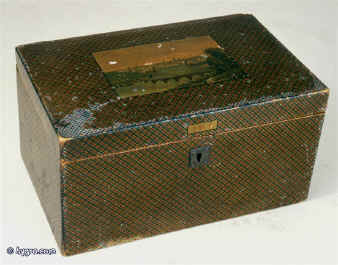
for another example of a Laurencekirk
caddy
see: http://hygra.com/uk/tc/tc106/

TC106
An important and rare Laurencekirk Scottish tea chest by C. Stiven having
wooden hinges to both the chest and the lift out canisters Circa 1810.
See also: Boxes
Painted by Artists
|
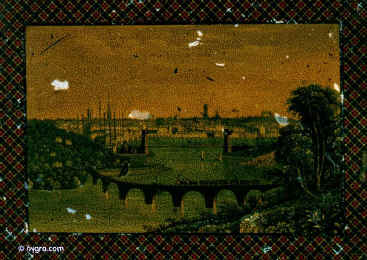
The top of the caddy is
painted with a picture depicting Aberdeen: in the foreground is the then
new railway bridge. The railway came to Aberdeen in 1850. In the
background is the city of Aberdeen.
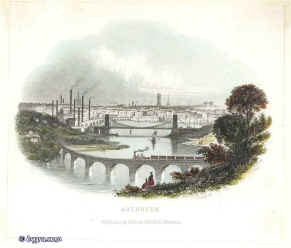
Hand coloured print depicting the same scene by Lizars
Sc of Aberdeen, published by William Mitchell Aberdeen.
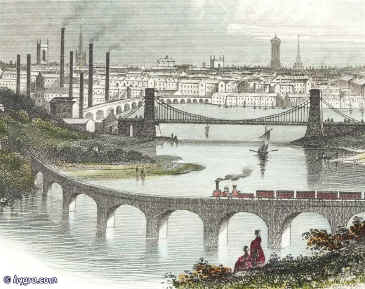
Detail:

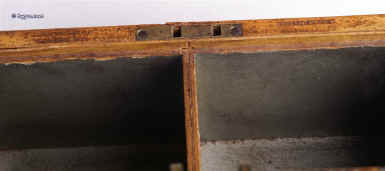
Stiven's boxes usually as here have an
embossed mark on the facing, near the lock, either as C. Stiven,
Charles Stiven and Sons, Stiven and Son, or variations. The word
Laurencekirk is also stamped. Even after the father's death, his name
remained on the label.
The caddy is stamped on one side of the lock: "C. STIVEN &
SONS LAURENCEKIRK" and on the other side: "BOX MAKERS TO HER
MAJESTY".

This caddy is featured in
our comprehensive book on antique boxes and tea caddies
published by Schiffer in 2003. Antique
Boxes, Tea Caddies, and Society, 1700--1880
Antigone Clarke & Joseph O'Kelly, ISBN: 0764316885
At the time of writing the
book we did not know the identity of the scene. It was only later when
I was looking at a charming diary/scrapbook kept by a 19th Century
Scottish girl that I came across the coloured print depicting the
scene on the caddy.
The first page of the
diary/scrapbook has a door which opens to reveal a young lady holding
a petition in her hand.
Google earth shows
the Satellite picture:

Wellington Suspension Bridge, spanning the Dee at Craiglug in the vicinity of Ferryhill, 1½ mile below Dee Bridge, was erected in 1831 at a cost of £10,000, and is 220 feet long by 22 wide. - The Railway Viaduct (1848), on the Aberdeen section of the Caledonian, crosses the Dee transversely, 3 furlongs above the Suspension Bridge, and designed by Messrs Locke &
Errington, now consists of 7 irongirder arches, each about 50 feet in span, with two land arches at its northern end.-
www.geo.ed.ac.uk/scotgaz/towns/townhistory617.html
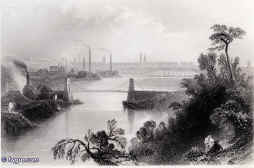
This print is one of a number of views from the
volume called : 'Views of the Ports,
Harbours & Watering Places of Great Britain' by Finden.
W. Bartlett was the artist of most of
these views.
This print shows a magical view of Aberdeen above the chain bridge in
North East Scotland. The print shows the Chain Bridge before the arrival
of the Railway in 1850.
Detail:
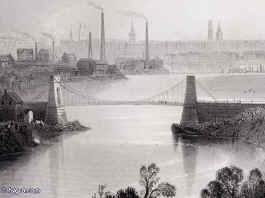
This print is included with the
caddy.
There are some recent photos of both
the Chain Bridge and the Rail Bridge at
www.panoramio.com/photo/4348602
|
The Scottish Box owes its distinction to a remarkable man, James
Sandy and its existence to another remarkable man, Lord Gardenstone. Its
commercial viability was nurtured by a gifted craftsman, Charles Stiven
and promoted by the dynastic family Smith.
James Sandy died in 1819, at the age of 53, an acknowledged genius
and a convivial man. This last quality must have been difficult to
maintain as, throughout his life, James Sandy had to fight against
tremendous odds. Due to an accident and the inappropriate
administrations of a quack doctor, James lost the use of one of his
legs, when he was a child of twelve. This infirmity did not deter him
from busying himself making violins and other musical instruments, in
spite the fact that the only tools he had were very rudimentary. He
triumphed over his primitive work conditions and achieved a degree of
success early on in his life. This enabled him to furnish his work bench
to a superior professional standard, which made it possible for him to
produce objects of high quality. He was musical himself and his striving
to understand the importance of scientific acoustic principles in the
course of making instruments, must have contributed to his wanderings in
the realms of science.
When James was seventeen, his family house was flooded. His mother
tried to move him to a higher floor. This resulted in another accident
and a second broken leg for the already crippled James. This additional
affliction rendered James completely unable to walk. Undaunted, he
continued to make the best use of the faculties he still possessed,
mainly his intellect and his dexterity. Ensconced in his bed, which he
adapted to double up as a work bench, he successfully tried his hand at
making clocks, telescopes, tools, machines, and false teeth! He received
an award for making a very serviceable false arm, for a man who lost his
arm in an accident!
James Sandy had a reputation as a rather eccentric genius, who
produced wondrous things and who hatched birds' eggs in his bed! This
was a tall story developed after James had adopted an orphaned gosling,
which grew up to be his pet goose and constant companion for many years.
This "artist of distinguished eminence" as he was described on
his tombstone, drew many visitors to his bedside. Inquiring foreign
travelers, as well as people from closer home, all admired James and his
work. His room must have been a hubbub of exchange of ideas and
bonhomie, as James liked to share both his inventions and his whisky
with his visitors.
In exchange the visitors must have allowed him glimpses of the
outside world, which stimulated his ingenuity and rendered his
activities applicable to the necessities and fashions of the time. Thus
James must have been aware of the habit of snuff taking and of the mess
which unhinged snuff boxes could create in the pockets of his visitors.
Furthermore, it is likely that he had seen and examined hand made
"blind" hinges, on Scottish or other north European snuff
boxes. The crudeness of the hinges, which defeated the object of keeping
the snuff dry, must have puzzled James, who set about solving the
problem.
It was James's grasp of both the disciplines of woodwork and clock
making, which enabled him to develop a process for cutting the hinges
with impeccable precision. James lived in Alyth, Perthshire in the East
side of Scotland . News of his new hinge must have traveled quite fast
to Kincardineshire, especially to Laurencekirk, which was only twenty
miles North East of Alyth and where another highly skilled craftsman,
Charles Stiven, lived and worked. It is just possible that Stiven had
found his own way of perfecting the concealed hinge. He certainly never
claimed to have done so. However, by the time of Sandy’s death, Stiven
had adopted the use of this particular hinge to such an extent, that any
box fitted with it was described as a Laurencekirk box.
Enter Francis, Lord Gardenstone. Lord Gardenstone had a distinguished
legal career; he became a Law Lord and acquired civic distinctions in
his native Scotland . He had an eccentric and expansive personality
which could not be satisfied within the mere confines of the law. He was
one of those gigantic characters which periodically, the 18th century
threw up and nurtured. His inspired efforts changed the social landscape
of his particular country, for the betterment of his fellow men. He
produced literary works; he was a patron of the arts and he was a
philanthropist in the most positive sense of the word.
Lord Gardenstone seemed to be on good terms with people in all walks
of life, appreciating the skills and insights they could offer. He had
two weaknesses, the first for snuff taking, the second, an extraordinary
liking for pigs. One pig in particular he indulged to the point of
allowing him to sleep on his bed and when he grew too large, to sleep on
his clothes when he undressed for the night. In this, he had something
in common with Sandy and his goose!
Stiven was born in 1753 and was persuaded to move to Laurencekirk by
Lord Gardenstone sometime around 1783. He was already acclaimed as a
snuff box maker and was obviously open to new ideas and designs, as his
adoption of the concealed hinge testifies. Brixhe's artistic skills
complemented Stiven's impeccable craftsmanship. Together they were
capable of masterminding a business of aesthetic integrity and
commercial viability.
Before Lord Gardenstone died in 1793, he had the satisfaction of
seeing his brainchild, a thriving box making enterprise, well underway.
The business continued successfully for about seventy years. When Stiven
died in 1820, his work was continued by his son Jonathan who had most
probably been trained by Brixhe in the art of painting. By the time
Jonathan had taken over, the firm already had the Royal Warrant, which
it continued to hold until its closure in 1868. The Stevens always
upheld high standards of workmanship and had the distinction of showing
their wares to the Royal family at Balmoral on several occasions.
Stiven's boxes usually have an embossed mark on the facing, near the
lock, either as C. Stiven, Charles Stiven and Sons, Stiven and Son, or
variations. The word Laurencekirk is also stamped. Even after the
father's death, his name remained on the label.
Stiven had premises in the coach house booking office, from where he
sold his wares. Travelers who bought his work must have been
instrumental in spreading both the characteristic hinge and the
particular quality of the work, further a field. The hinge soon reached
the West of Scotland and established itself in Ayrshire. The first time
the hinge was used in this area is clouded in legend. One version of
events recounts how a Laurencekirk snuff box was repaired in Cumnock by
William Crawford, who realizing the special quality of the hinge, set
about trying to recreate it with the co operation of his boss Mr.
Willie.
|
Please click on images to enlarge or |
slide show |thumbnail index |
Further Detailed pictures of the caddy
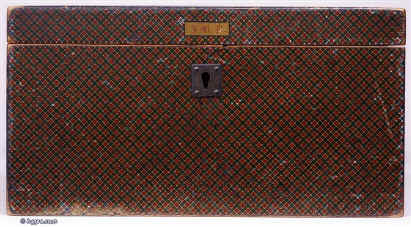
|
Front view. |
Please click on images to enlarge or |
slide show |thumbnail index |
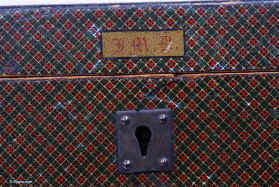
|
Escutcheon
|
There is a crack in the lid
near the hinge which has been crudely repaired in the past. However, the
structure is stable, and in our view further restoration could reduce
the historic integrity of the caddy.
|
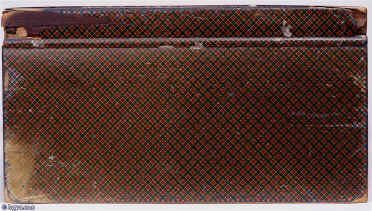
|
Please click on images to enlarge or |
slide show |thumbnail index |
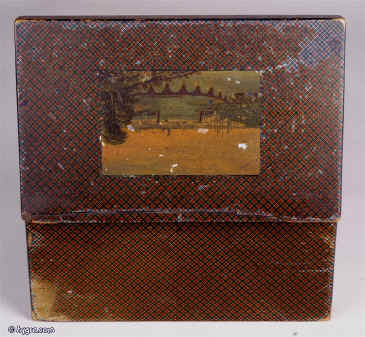
|
There is a crack in the lid
near the hinge which has been crudely repaired in the past. However, the
structure is stable, and in our view further restoration could reduce
the historic integrity of the caddy.
|
Please click on images to enlarge
Please click on images to enlarge or |
slide show |thumbnail index |
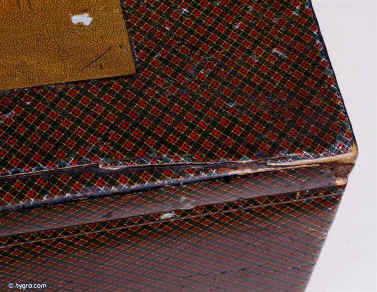
|
A
|
It is interesting to note that the wood used to
make the hinge is cut almost exactly on the quarter.
|

|
Please click on images to enlarge or |
slide show |thumbnail index |
Please click on images to enlarge
Please click on images to enlarge or |
slide show |thumbnail index |
Please click on images to enlarge
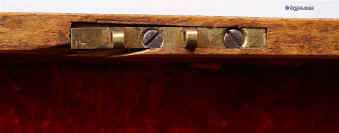
|
A
|
Stiven's boxes usually as here have an embossed
mark on the facing, near the lock, either as C. Stiven, Charles Stiven
and Sons, Stiven and Son, or variations. The word Laurencekirk is also
stamped. Even after the father's death, his name remained on the label.
The caddy is stamped on one side of the lock: "C. STIVEN & SONS
LAURENCEKIRK" and on the other side: "BOX MAKERS TO HER
MAJESTY".
|
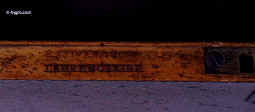
|
Please click on images to enlarge or |
slide show |thumbnail index |
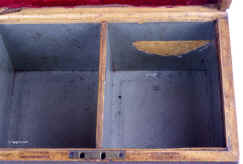
|
Although the caddy retains much of its original
leading it is missing its supplementary lids.
|
Please click on images to enlarge or |
slide show |thumbnail index |
Please click on images to enlarge
|
slide show |
thumbnail index |
Please click on images to enlarge or |
slide show |thumbnail index |
All text and images and linked images are ©
1999-2008 Antigone Clarke and Joseph O'Kelly. If you require any further
information on permitted use, or a licence to republish any material, email us
at copyright@hygra.com
|